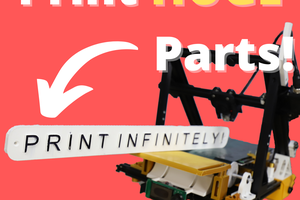Demo Video
**NOTE: If you are hoping to get a quick overview of this project, please watch this brief two minute video.**
[Figure 1: Robot Demo Video]
Background
The Problem with Traditional Manufacturing
Traditional manufacturing involves developing custom machinery that is perfectly optimized to mass produce a specific part. Examples of such machines include injection molds, vacuum formers, and die presses. While building custom machinery is extremely expensive, the costs are recouped after millions of parts are produced. But what happens if manufacturers do not want to produce millions of parts?
Unfortunately, the high initial costs to set up a manufacturing line inhibits companies, specifically startups and Small Medium Enterprises (SMEs), from running smaller production batches. In addition to the large expenses, there are also long lead times required to set up a production line. Both of these factors discourage companies from updating/modifying a part’s design once the production line is finished. Ideally, a manufacturing engineer should be able to iterate on designs as often and as easily as a software engineer.
The Potential of 3D Printing Farms
A 3D printing farm is a facility that contains a large fleet of 3D printers which work together to mass produce parts. With custom software, these 3D printers are networked together to process print jobs; similar to the way servers in a server farm are networked together to process data. A 3D printer is the polar opposite of the custom machines used in traditional factories. A custom machine is precisely designed to manufacture a specific part, while a 3D printer can print a part of any geometry; albeit not very efficiently. At scale, it will always be more economical to use a custom machine instead of a 3D printer to manufacture parts. However, 3D printers have several advantages that make them preferable for low volume production. A 3D printer can start printing parts as soon as it receives that part’s digital CAD file. On the other hand, traditional factories require a large initial lead time to start manufacturing new parts. It takes a long time to design, build, and deploy the required custom machinery. It is important to note that once a custom machine is built, like an injection mold or die press, it will produce parts exponentially quicker than a 3D printer. However, if we factor in the lead time required to build the custom machines, the 3D printers will be optimal up to a certain number of parts. This niche is the area of production between prototyping and mass production.
Since a 3D printer can instantly switch between manufacturing different parts, manufactures can update/refine a part’s design as they wish. This enables a part to have more iteration cycles and for the manufacturer to be respond quickly to market demands. Essentially, a 3D printer allows a manufacturing engineer to adopt the agile design ideology[of a software engineer. Moreover, 3D printing allows manufacturers to explore areas like mass customization. For example, instead of a company producing 1000 identical shoe soles with an injection mold, they can 3D print 1000 unique shoe soles that are each customized to fit a specific person. From a 3D printing perspective, it takes as much time to print 1000 copies of the same part as it does to print 1000 unique parts (of roughly the same size).
Making 3D Printer Farms more Efficient with Automation
Before we get carried away by the potential of 3D printing, it is important to acknowledge that the manufacturing capacity of a 3D printer farm that contains hundreds of 3D printers is still dwarfed by a traditional factory. Therefore, it is vital that we explore every way that we can improve the efficiency of a 3D printer farm. One obvious avenue is automation. A key bottleneck in 3D printer farms is the requirement of human labour to start/remove print jobs from the machine. By developing some sort of robotic...
Read more » Swaleh Owais
Swaleh Owais

 Guis
Guis


Very cool! What's the estimated cost for this? Estimated build time?